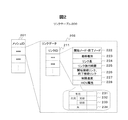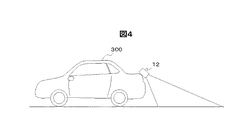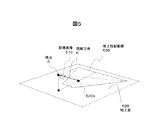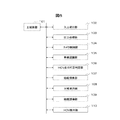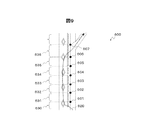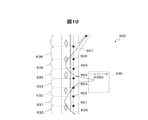JP2011137726A - Navigation device and guidance method thereof - Google Patents
Navigation device and guidance method thereof Download PDFInfo
- Publication number
- JP2011137726A JP2011137726A JP2009298078A JP2009298078A JP2011137726A JP 2011137726 A JP2011137726 A JP 2011137726A JP 2009298078 A JP2009298078 A JP 2009298078A JP 2009298078 A JP2009298078 A JP 2009298078A JP 2011137726 A JP2011137726 A JP 2011137726A
- Authority
- JP
- Japan
- Prior art keywords
- lane
- section
- guidance
- exit
- hov
- Prior art date
- Legal status (The legal status is an assumption and is not a legal conclusion. Google has not performed a legal analysis and makes no representation as to the accuracy of the status listed.)
- Pending
Links
Images
Landscapes
- Navigation (AREA)
Abstract
Description
本発明は、ナビゲーション装置の技術に関するものである。 The present invention relates to a navigation device technology.
従来、ナビゲーション装置では、HOV(High-Occupancy Vehicles)レーン等の特定の条件を満たす車両のみが走行可能な車線に対応する経路誘導の技術が用いられている。特許文献1には、このようなナビゲーション装置についての技術が記載されている。なお、HOVレーンは、カープールレーンとも呼ばれる。 2. Description of the Related Art Conventionally, a navigation apparatus uses a route guidance technique corresponding to a lane in which only a vehicle that satisfies a specific condition, such as an HOV (High-Occupancy Vehicles) lane, can travel. Patent Document 1 describes a technique regarding such a navigation device. The HOV lane is also called a car pool lane.
しかし、上記のようなナビゲーション装置は、自車位置から推奨経路上に存在する特別車線(HOVレーン)および一般車線を備えた複数車線道路の分岐点または出口までの間における特別車線から一般車線へ離脱するための離脱許容区間および特別車線に進入するための進入許容区間の少なくとも一方の残数をユーザに通知するものであるため、ユーザは、推奨経路に従って走行するために出入りすべき出入り口を直感的に把握するのが難しい。 However, the navigation device as described above is from a special lane to a general lane between the own vehicle position and a special lane (HOV lane) existing on the recommended route and a branch point or exit of a multi-lane road having a general lane. Since the user is informed of the remaining number of at least one of the allowance section for leaving and the entry allowance section for entering the special lane, the user can intuitively know the entrance and exit to travel in accordance with the recommended route. Difficult to grasp.
本発明の目的は、推奨経路に従って走行するために出入りすべき出入り口をユーザが容易に把握できるナビゲーション技術を提供することにある。 An object of the present invention is to provide a navigation technique that allows a user to easily grasp an entrance / exit to be in and out in order to travel according to a recommended route.
上記課題を解決すべく、本発明に係るナビゲーション装置は、道路の所定の区間ごとに、所定の条件を満たすことにより通行可能となる車線(以下条件付き車線という)の出入りの可否を含む車線情報を記憶する記憶手段と、指定された目的地までの推奨経路を探索する経路探索手段と、前記条件付き車線の出入り可能な道路の区間において、前記条件付き車線への進入または前記条件付き車線からの退出の案内を行う車線案内手段と、を備え、前記車線案内手段は、前記条件付き車線からの退出可能区間と、前記退出可能区間よりも手前の前記条件付き車線への進入可能区間と、が前記推奨経路上に存在する場合に、前記進入可能区間において、当該条件付き車線への進入案内を行う、ことを特徴とする。 In order to solve the above-mentioned problem, the navigation device according to the present invention includes lane information including whether or not a lane (hereinafter referred to as a conditional lane) that can be passed by satisfying a predetermined condition for each predetermined section of the road. Storage means for storing, route search means for searching for a recommended route to the designated destination, and entry into the conditional lane or from the conditional lane in a section of the road where the conditional lane can enter and exit Lane guidance means for guiding the exit of the lane, the lane guidance means, the section that can exit from the conditional lane, the section that can enter the conditional lane before the section that can leave, and Is provided on the recommended route, the approach guidance to the conditional lane is performed in the approachable section.
また、本発明に係るナビゲーション装置の案内方法では、前記ナビゲーション装置は、道路の所定の区間ごとに、所定の条件を満たすことにより通行可能となる車線(以下条件付き車線という)の出入りの可否を含む車線情報を記憶する記憶手段と、指定された目的地までの推奨経路を探索する経路探索手段と、前記条件付き車線の出入り可能な道路の区間において、前記条件付き車線への進入または前記条件付き車線からの退出の案内を行う車線案内手段と、を備え、前記車線案内手段は、前記条件付き車線からの退出可能区間と、前記退出可能区間よりも手前の前記条件付き車線への進入可能区間と、が前記推奨経路上に存在する場合に、前記進入可能区間において、当該条件付き車線への進入案内を行うステップ、を実施することを特徴とする。 In the navigation device guidance method according to the present invention, the navigation device determines whether or not a lane (hereinafter referred to as a conditional lane) that can be passed by satisfying a predetermined condition for each predetermined section of the road. Storage means for storing lane information including, route search means for searching for a recommended route to a specified destination, and entry to the conditional lane or the condition in a section of the road where the conditional lane can enter and exit Lane guidance means for guiding exit from the attached lane, wherein the lane guidance means is capable of exiting the conditional lane and entering the conditional lane before the exitable section. When the section exists on the recommended route, the step of performing the approach guidance to the conditional lane in the section where the entry is possible is performed. To.
本願発明によれば、推奨経路に従って走行するために出入りすべき出入り口をユーザが容易に把握できるナビゲーション技術を提供することが可能となる。 According to the present invention, it is possible to provide a navigation technique that allows a user to easily grasp an entrance / exit to be in and out in order to travel according to a recommended route.
以下に、本発明の第一の実施形態を適用したナビゲーション装置について、図面を参照して説明する。 A navigation apparatus to which a first embodiment of the present invention is applied will be described below with reference to the drawings.
図1に、ナビゲーション装置100の全体構成図を示す。ナビゲーション装置100は、地図情報を表示して、ナビゲーション装置100の現在地を示す地点と、設定された目的地までの経路を誘導する情報とを示すことが可能ないわゆるナビゲーション装置である。
FIG. 1 shows an overall configuration diagram of the
ナビゲーション装置100は、演算処理部1と、ディスプレイ2と、記憶装置3と、音声入出力装置4(音声入力装置としてマイクロフォン41、音声出力装置としてスピーカ42を備える)と、入力装置5と、ROM装置6と、車速センサ7と、ジャイロセンサ8と、GPS(Global Positioning System)受信装置9と、FM多重放送受信装置10と、ビーコン受信装置11と、カメラ12と、車載ネットワーク通信装置13と、を備えている。
The
演算処理部1は、様々な処理を行う中心的ユニットである。例えば各種センサ7,8やGPS受信装置9、FM多重放送受信装置10等から出力される情報に基づいて現在地を算出する。また、得られた現在地情報に基づいて、表示に必要な地図データを記憶装置3あるいはROM装置6から読み出す。
The arithmetic processing unit 1 is a central unit that performs various processes. For example, the current location is calculated based on information output from the
また、演算処理部1は、読み出した地図データをグラフィックス展開し、そこに現在地を示すマークを重ねてディスプレイ2へ表示する。また、記憶装置3あるいはROM装置6に記憶されている地図データ等を用いて、ユーザから指示された出発地又は現在地と、目的地(または、経由地や立ち寄り地)とを結ぶ最適な経路(推奨経路)を探索する。また、スピーカ42やディスプレイ2を用いてユーザを誘導する。
The arithmetic processing unit 1 develops the read map data in graphics, and displays a mark indicating the current location on the
また、演算処理部1は、後述するように、経路誘導を行う際に、HOV(High-Occupancy Vehicles)レーンへの出入り口の走行を案内することができる。なお、HOVレーンは、乗車人数が規定の乗車人数(例えば運転者を含めて2人)以上である車両や、特定の基準(低燃費、あるいは低公害)を満たす車両のみが走行可能として規定された車線のことである。 Further, as will be described later, the arithmetic processing unit 1 can guide traveling at the entrance to an HOV (High-Occupancy Vehicles) lane when performing route guidance. Note that the HOV lane is defined such that only vehicles having a specified number of passengers (for example, two people including the driver) or more and vehicles satisfying a specific standard (low fuel consumption or low pollution) can travel. Lane.
ナビゲーション装置100の演算処理部1は、各デバイス間をバス25で接続した構成である。演算処理部1は、数値演算及び各デバイスを制御するといった様々な処理を実行するCPU(Central Processing Unit)21と、記憶装置3から読み出した地図データ、演算データなどを格納するRAM(Random Access Memory)22と、プログラムやデータを格納するROM(Read Only Memory)23と、各種ハードウェアを演算処理部1と接続するためのI/F(インターフェイス)24と、を有する。
The arithmetic processing unit 1 of the
ディスプレイ2は、演算処理部1等で生成されたグラフィックス情報を表示するユニットである。ディスプレイ2は、液晶ディスプレイ、有機ELディスプレイなどで構成される。
The
記憶装置3は、HDD(Hard Disk Drive)や不揮発性メモリカードといった、少なくとも読み書きが可能な記憶媒体で構成される。
The
この記憶媒体には、通常の経路探索装置に必要な地図データ(地図上の道路を構成するリンクのリンクデータを含む)であるリンクテーブル200および推奨経路上のHOVレーンからの出口の位置とその案内の要否を特定する出口案内管理テーブル250が記憶されている。 This storage medium includes a link table 200 which is map data (including link data of links constituting a road on the map) necessary for a normal route search device, and the position of the exit from the HOV lane on the recommended route An exit guidance management table 250 for specifying whether or not guidance is necessary is stored.
図2は、リンクテーブル200の構成を示す図である。リンクテーブル200は、地図上の区画された領域であるメッシュの識別コード(メッシュID)201ごとに、そのメッシュ領域に含まれる道路を構成する各リンクのリンクデータ202を含んでいる。
FIG. 2 is a diagram showing the configuration of the link table 200. The link table 200 includes, for each mesh identification code (mesh ID) 201, which is a partitioned area on the map,
リンクデータ202は、リンクの識別子であるリンクID211ごとに、リンクを構成する2つのノード(開始ノード、終了ノード)の座標情報222、リンクを含む道路の種別を示す道路種別223、リンクの長さを示すリンク長224、予め記憶されたリンク旅行時間225、当該リンクの開始ノードに接続するリンクである開始接続リンクと、当該リンクの終了ノードに接続するリンクである終了接続リンクと、を特定する開始接続リンク、終了接続リンク226、リンクを含む道路の制限速度を示す制限速度227、リンクごとのHOVレーンの設置状況に関する属性を特定するHOV属性228などを含んでいる。
For each
HOV属性228は、当該リンクがHOVレーンのみから構成されている道路である場合には、「専用」の属性231を備え、当該リンクがHOVレーンを備えない道路である場合には、「無」の属性234を備える。また、当該リンクがHOVレーンと通常レーンとを併せて有するものであって、かつ、HOVレーンと通常レーンとの間の車線変更ができない道路である場合には、「共用−実線」の属性232を備え、当該リンクがHOVレーンと通常レーンとを併せて有するものであって、かつ、HOVレーンと通常レーンとの間の車線変更が可能な道路である場合には、「共用−破線」の属性233を備える。すなわち、HOV属性228には、HOVレーンの設置状況を特定する情報が格納されるといえる。
The
なお、ここでは、リンクを構成する2つのノードについて開始ノードと終了ノードとを区別することで、同じ道路の上り方向と下り方向とを、それぞれ別のリンクとして管理するようにしている。 Here, by distinguishing the start node and the end node for the two nodes constituting the link, the upward direction and the downward direction of the same road are managed as different links.
図3は、出口案内管理テーブル250の構成を示す図である。出口案内管理テーブル250は、推奨経路に含まれるHOV出口を特定する経路上のHOV出口リンク251を含んでいる。
FIG. 3 is a diagram showing the configuration of the exit guide management table 250. The exit guide management table 250 includes an
図1に戻って説明する。音声入出力装置4は、音声入力装置としてマイクロフォン41と、音声出力装置としてスピーカ42と、を備える。マイクロフォン41は、ユーザやその他の搭乗者が発した声などのナビゲーション装置100の外部の音声を取得する。
Returning to FIG. The voice input /
スピーカ42は、演算処理部1で生成されたユーザへのメッセージを音声として出力する。マイクロフォン41とスピーカ42は、車両の所定の部位に、別個に配されている。ただし、一体の筐体に収納されていても良い。ナビゲーション装置100は、マイクロフォン41及びスピーカ42を、それぞれ複数備えることができる。
The
入力装置5は、ユーザからの指示をユーザによる操作を介して受け付ける装置である。入力装置5は、タッチパネル51と、ダイヤルスイッチ52と、その他のハードスイッチ(図示しない)であるスクロールキー、縮尺変更キーなどで構成される。また、入力装置5には、ナビゲーション装置100に対して遠隔で操作指示を行うことができるリモートコントローラが含まれる。リモートコントローラは、ダイヤルスイッチやスクロールキー、縮尺変更キーなどを備え、各キーやスイッチが操作された情報をナビゲーション装置100に送出することができる。
The
タッチパネル51は、ディスプレイ2の表示面側に搭載され、表示画面を透視可能である。タッチパネル51は、ディスプレイ2に表示された画像のXY座標と対応したタッチ位置を特定し、タッチ位置を座標に変換して出力する。タッチパネル51は、感圧式または静電式の入力検出素子などにより構成される。
The
ダイヤルスイッチ52は、時計回り及び反時計回りに回転可能に構成され、所定の角度の回転ごとにパルス信号を発生し、演算処理部1に出力する。演算処理部1では、パルス信号の数から、回転角度を求める。
The
ROM装置6は、CD-ROMやDVD-ROM等のROM(Read Only Memory)や、IC(Integrated Circuit)カードといった、少なくとも読み取りが可能な記憶媒体で構成されている。この記憶媒体には、例えば、動画データや、音声データなどが記憶されている。 The ROM device 6 includes at least a readable storage medium such as a ROM (Read Only Memory) such as a CD-ROM or a DVD-ROM, or an IC (Integrated Circuit) card. In this storage medium, for example, moving image data, audio data, and the like are stored.
車速センサ7,ジャイロセンサ8およびGPS受信装置9は、ナビゲーション装置100で現在地(自車位置)を検出するために使用されるものである。車速センサ7は、車速を算出するのに用いる値を出力するセンサである。ジャイロセンサ8は、光ファイバジャイロや振動ジャイロ等で構成され、移動体の回転による角速度を検出するものである。GPS受信装置9は、GPS衛星からの信号を受信し移動体とGPS衛星間の距離と距離の変化率とを3個以上の衛星に対して測定することで移動体の現在地、進行速度および進行方位を測定するものである。
The
FM多重放送受信装置10は、FM放送局から送られてくるFM多重放送信号を受信する。FM多重放送には、VICS(Vehicle Information Communication System:登録商標)情報の概略現況交通情報、規制情報、SA/PA(サービスエリア/パーキングエリア)情報、駐車場情報、天気情報などやFM多重一般情報としてラジオ局が提供する文字情報などがある。
The FM
ビーコン受信装置11は、VICS情報などの概略現況交通情報、規制情報、SA/PA(サービスエリア/パーキングエリア)情報、駐車場情報、天気情報や緊急警報などを受信する。例えば、光により通信する光ビーコン、電波により通信する電波ビーコン等の受信装置である。
The
図4は、車両300の後方に取り付けられたカメラ12を示す。カメラ12は、やや下を向いており、車両の後方の地上面をCCD(Charge Coupled Device)やCMOS(Complementary Metal Oxide Semiconductor)イメージセンサ等の撮像素子を用いて撮像する。なお、カメラ12が取り付けられる位置に制限はなく、例えば、カメラ12は車両300の前方に取り付けられて車両の前方の地上面を撮像するものであってもよい。
FIG. 4 shows the
図5は、図4のカメラ12にて撮像した画像を用いた地上投影画像の生成方法を説明するための図である。後述するカメラ制御部104は、カメラ12の視点Pの位置(車両内の所定位置を原点とする三次元空間における座標位置)と撮像方向(視線方向)Kを求める。そして、カメラ制御部104は、撮像画像510を、カメラ12の視点Pの位置から撮像方向Kに向けて、地上面520に投影し、地上投影画像530を生成する。なお、撮像方向Kは、撮像画像510の中心と垂直に交わる。また、カメラ12の視点Pから撮像画像510までの距離は、予め定められている。こうして生成される地上投影画像530は、車両の上空から車両周辺を鳥瞰したような画像となる。
FIG. 5 is a diagram for explaining a method of generating a ground projection image using an image captured by the
車載ネットワーク通信装置13は、ナビゲーション装置100を、図示しない車両の制御ネットワーク規格であるCAN等に対応するネットワークに接続させ、ネットワークに接続された他の車両制御装置であるECU(Electronic control unit)とCANメッセージをやり取りすることで通信を行う装置である。
The in-vehicle
図6は、演算処理部1の機能ブロック図である。図示するように、演算処理部1は、主制御部101と、入力受付部102と、出力処理部103と、カメラ制御部104と、車線認識部105と、HOV走行可否判定部106と、経路探索部107と、分岐案内部108と、経路誘導部109と、HOV案内部110と、を有する。
FIG. 6 is a functional block diagram of the arithmetic processing unit 1. As shown in the figure, the arithmetic processing unit 1 includes a
主制御部101は、様々な処理を行う中心的な機能部であり、処理内容に応じて、他の処理部を制御する。また、各種センサ、GPS受信装置9等の情報を取得し、マップマッチング処理等を行って現在地を特定する。また、随時、走行した日付および時刻と、位置と、を対応付けて、リンクごとに走行履歴を記憶装置3に記憶する。さらに、各処理部からの要求に応じて、現在時刻を出力する。なお、主制御部101は、ナビゲーション装置100が備える各種設定情報を管理する。すなわち、主制御部101は、ユーザから、当該各種設定情報として設定する情報を入力受付部102を介して受け付けて、記憶装置3の所定の位置に格納する。主制御部101は、各種設定情報として、HOVレーンの利用に関する情報(例えば、HOVレーンを積極的に利用することについて真、偽のいずれかの情報)を受け付けて、記憶装置3に格納する。主制御部101は、他の制御部から当該各種設定情報の提供依頼を受け付けると、当該各種設定情報を依頼元の制御部に受け渡す。
The
入力受付部102は、入力装置5またはマイクロフォン41を介して入力されたユーザからの指示を受け付け、その要求内容に対応する処理を実行するように演算処理部1の各部を制御する。例えば、ユーザが推奨経路の探索を要求したときは、目的地を設定するため、地図をディスプレイ2に表示する処理を出力処理部103に要求する。
The
出力処理部103は、例えばポリゴン情報等の表示させる画面情報を受け取り、ディスプレイ2に描画するための信号に変換してディスプレイ2に対して描画する指示を行う。
The
カメラ制御部104は、カメラ12の動作を制御する。例えば、カメラ12の撮像の開始・終了のタイミングを設定する。また、撮像した画像を車線認識部105への送信を制御する。
The
車線認識部105は、カメラ12で撮像した画像を、画像データとして取得する。そして、取得した画像を、表示のための画像(地上投影画像)に変換する。また、取得した画像から、道路の路面に敷設あるいは着色された標識等を認識し、自車が走行する車線の特定を行う。例えば、後述するように、車線認識部105は、HOVレーンであることを示す標識(菱形のペイント)等の存在を認識し、画像中の左右中央付近に当該標識が存在する場合には、車両300がHOVレーンを走行しているものと判定する。あるいは、車線認識部105は、画像中の左右中央付近ではなく、左右中央付近よりも左右のいずれかに片寄った位置に当該標識が認識され、左右中央付近からみて車線の標識より端側に当該標識が認識される場合には、HOVレーンではない隣のレーンを走行しているものと判定する。
The
HOV走行可否判定部106は、自車300がHOVレーンを走行可能であるか否かを判定する。当該走行可否の判定においては、HOV走行可否判定部106は、車載ネットワーク通信装置13を介して、自車300の車載ネットワークを流れる通信情報に基づいて自車300の車種等を判定し、HOVレーンを走行可能な車種であるか否かを判定する。もちろん、HOVレーンの走行可否の判定処理においては、これに限られず、HOV走行可否判定部106は、車両のシートに取り付けられた図示しない荷重センサから乗車人数を特定し、または、シートベルトの着用センサを介して乗車人数を特定して、HOVレーンを走行可能な乗車人数に達しているか否かを判定するようにしてもよい。
The HOV traveling
経路探索部107は、ユーザから指示された出発地又は現在地と、目的地とを結ぶ最適な経路(推奨経路)を探索する。当該経路探索においては、ダイクストラ法等の経路探索ロジックを用いて、道路の所定の区間(リンク)に対して予め設定されたリンクコストに基づいて経路を探索する。なお、当該処理においては、自車がHOVレーンを走行可能な状況にあるか否かを上記HOV走行可否判定部106に対して判定するよう依頼し、走行可能な状況にある場合に、HOVレーンを利用する経路を優先して、推奨経路を探索する。走行可能な状況にない場合には、経路探索部107は、HOVレーンを考慮しないで、リンクコストが最小となる経路を探索する。なお、経路探索部107は、当該処理において、HOVレーンを走行可能な状況にないと判定した場合であっても、既に自車がHOVレーンを走行中であれば、HOVレーンを利用する経路を優先して推奨経路を探索する。経路探索部107は、自車がHOVレーンをすでに走行しているか否かを判定する際には、現在地が属するリンクのHOV属性228を参照して、「専用」属性であれば、HOVレーンを走行していると判定し、「無」属性であれば、HOVレーンを走行していないと判定し、「共用」属性であれば、走行している車線がHOVレーンであるか否かについて車線認識部105に判定を依頼することにより判定する。
The
分岐案内部108は、他の道路との合流点や他の道路への分岐点等の存在や位置を、映像や音声を用いてユーザに案内する。例えば、分岐案内部108は、高速道路等の支線と本線との合流位置の手前から、合流点が近い旨や合流点までの概算距離を知らせる表示を、出力処理部103を介してディスプレイ2に出力させる。また例えば、分岐案内部108は、高速道路の本線からランプ道への分岐点において、いずれの車線を走行すればよいかを、スピーカ42を介して音声によりユーザへ知らせる。
The
経路誘導部109は、車両の現在地が推奨経路から逸脱しないよう、スピーカ42やディスプレイ2を用いてユーザの運転操作を誘導する。
The
HOV案内部110は、HOVレーンの出入り口におけるHOVレーンと通常レーンとの間の出入りに関して、ユーザに対して案内を行う。具体的には、HOV案内部110は、HOVレーンの出入り口(一般的には、出口、入口は共用される)において、HOVレーンに進入すべき旨、HOVレーンから退出すべき旨、あるいは走行レーンを維持すべき旨等をユーザに対して音声・画像等を用いて案内する。またその案内においては、後述するように、HOV案内部110は、推奨経路から逸脱せずにHOVレーンから通常レーンへ退出することができる場合に、その手前のHOVレーン入口においてHOVレーンへの進入を案内することができる。そのため、HOV案内部110は、HOVレーンから退出できないために推奨経路から逸脱せざるを得なくなる場合には、たとえ直近に進入可能なHOVレーン出入口があっても、当該出入口においてはHOVレーンへ進入するよう案内することはないといえる。
The
なお、HOV案内部110は、HOVレーンからの退出区間において、退出すべき旨の案内を行い、HOVレーンへの進入区間において、進入すべき旨の案内を行う。また、HOV案内部110は、HOVレーンからの退出区間として、HOVレーンから退出することが可能な前記推奨経路上の区間のうち、目的地に近い区間を特定する。なるべくHOVレーンを走行するようにするためである。
Note that the
また、HOV案内部110は、推奨経路上において退出区間よりも手前にHOVレーンへ進入可能な区間が存在しない場合には、退出案内と、進入案内と、のいずれの案内も行わない。
In addition, when there is no section that can enter the HOV lane before the exit section on the recommended route, the
また、HOV案内部110は、進入案内後に車両のHOVレーンへの進入を検知し、退出区間に到達する前に車両のHOVレーンからの退出を検知した場合には、退出案内を中止する。なお、HOV案内部110は、退出案内を中止した場合、再度、推奨経路上のHOVレーンからの退出区間を特定して、退出案内と進入案内とを行う。
Further, the
上記した演算処理部1の各機能部、すなわち主制御部101、入力受付部102、出力処理部103、カメラ制御部104、車線認識部105、HOV走行可否判定部106、経路探索部107、分岐案内部108、経路誘導部109、HOV案内部110は、CPU21が所定のプログラムを読み込み実行することにより構築される。そのため、RAM22には、各機能部の処理を実現するためのプログラムが記憶されている。
Each functional unit of the arithmetic processing unit 1 described above, that is, the
なお、上記した各構成要素は、ナビゲーション装置100の構成を、理解を容易にするために、主な処理内容に応じて分類したものである。そのため、構成要素の分類の仕方やその名称によって、本願発明が制限されることはない。ナビゲーション装置100の構成は、処理内容に応じて、さらに多くの構成要素に分類することもできる。また、1つの構成要素がさらに多くの処理を実行するように分類することもできる。
In addition, each above-mentioned component is classified according to the main processing content, in order to make an understanding easy the structure of the
また、各機能部は、ハードウェア(ASIC、GPUなど)により構築されてもよい。また、各機能部の処理が一つのハードウェアで実行されてもよいし、複数のハードウェアで実行されてもよい。 Each functional unit may be constructed by hardware (ASIC, GPU, etc.). Further, the processing of each functional unit may be executed by one hardware or may be executed by a plurality of hardware.
[動作の説明]次に、ナビゲーション装置100が実施するHOV案内処理の動作について説明する。図7は、ナビゲーション装置100が実施するHOV案内処理を示すフロー図である。このフローは、ナビゲーション装置100に電源が投入されて、ナビゲーション装置100が起動すると開始される。
[Description of Operation] Next, the operation of the HOV guidance process performed by the
まず、HOV案内部110は、ナビゲーション装置100がHOVレーンを利用する設定になっているか否かを判定する(ステップS001)。具体的には、HOV案内部110は、ナビゲーション装置100が備える各種設定情報のうち、HOVレーンの利用に関する情報(例えば、HOVレーンを利用することについて設定された真、偽の情報)を主制御部101から取得する。そして、HOV案内部110は、当該情報を参照してHOVレーンを利用する設定であるか否かを判定する。
First, the
HOVレーンを利用する設定になっている場合(ステップS001にて「Yes」)、HOV案内部110は、自車がHOVレーンを走行可能であるか否かを判定する(ステップS002)。具体的には、HOV案内部110は、HOV走行利用可否判定部106に依頼して、自車がHOVレーンを走行可能であるか否かを判定する。
When it is set to use the HOV lane (“Yes” in step S001), the
自車がHOVレーンを利用する設定になっていない場合(ステップS001にて「No」)、または、自車がHOVレーンを走行不可能である場合(ステップS002にて「No」)、HOV案内部110は、HOV案内処理を終了させる。
If the vehicle is not set to use the HOV lane (“No” in step S001), or if the vehicle cannot travel in the HOV lane (“No” in step S002), the HOV guidance The
自車がHOVレーンを走行可能な場合(ステップS002にて「Yes」)、HOV案内部110は、推奨経路上で、HOV属性が「共用」のリンクが連続する道路区間を一つまたは複数特定する(ステップS003)。具体的には、HOV案内部110は、推奨経路の情報を主制御部101から取得し、推奨経路に含まれる各リンクのHOV属性228をリンクテーブル200から読み出して、HOV属性228が「共用−破線」233であるリンクを特定する。そして、HOV案内部110は、当該リンクが連続するリンクである場合には連続するリンクをまとめて、一つの道路区間として特定する。
If the vehicle can travel on the HOV lane (“Yes” in step S002), the
次に、HOV案内部110は、「共用−破線」233のHOV属性を備えるリンクを含む道路区間(ステップS003にて特定した道路区間)のうち、自車位置から直近の道路区間を選択する(ステップS004)。
Next, the
次に、HOV案内部110は、ステップS004にて選択された道路区間について、「共用−破線」のHOV属性を備える最後尾のリンクを出口案内リンクとして出口案内管理テーブル250のHOV出口リンク251に登録する(ステップS005)。
Next, for the road section selected in step S004, the
次に、HOV案内部110は、ステップS005において出口案内リンクが一つ以上登録されたか否かを判定する(ステップS006)。出口案内リンクが一つ以上登録されなかった場合(ステップS006において「No」)、HOV案内部110は、HOV案内処理を終了させる。
Next, the
出口案内リンクが一つ以上登録された場合(ステップS006において「Yes」)、HOV案内部110は、選択された道路区間を構成するリンクであって、「共用−破線」の属性を備えるリンクのうち、最後尾以外のリンクにおいて、HOV入口案内を行う(ステップS007)。具体的には、HOV案内部110は、図8に示す画面400または画面450を用いて、ユーザに対してHOVレーンに進入するよう案内する。つまり、HOV案内部110は、選択された道路区間を構成するリンクであって、「共用−破線」の属性を備えるリンクのうち、最後尾以外のリンクが複数存在する場合には、当該リンクへ近づいた順にHOVレーンへの進入を案内する。
When one or more exit guide links are registered (“Yes” in step S006), the
図8は、HOV案内部110が出力する画面を説明する図である。図8(a)は、経路誘導処理におけるHOV案内部110によるHOV入口案内の画面例である。図8(b)は、経路表示におけるHOV案内部110によるHOV入口案内の画面例である。
図8(a)に示された画面400は、前方の道路を示す前方道路図形401と、走行レーンを示す走行レーン表示図形402と、HOVレーンが前方に存在することを示すHOVレーン図形403と、HOVレーンへの進入を行う地点までの距離を図形により表示する距離表示図形410と、距離表示図形410に重畳されて表示される距離メータ411と、HOVレーンへの進入を行う地点までの距離を数値により表示する距離表示412と、により構成される。距離メータ411と、距離表示412には、HOVレーンへの進入を行なう地点までの距離が示されるため、ユーザはHOVレーンへ進入するための運転操作を行うべきタイミングを把握することができる。また、走行レーン表示図形402の前方を示す位置に、HOVレーン図形403が表示されるため、ユーザはHOVレーンへの進入を行うべきことと、進入する際の走行レーンの把握と、を把握することができる。
FIG. 8 is a diagram for explaining a screen output by the
A
図8(b)に示された画面450は、推奨経路上の所定のチェックポイント(例えば経路上右左折を行う交差点等)を示すチェックポイント図形460と、チェックポイント図形460上に重畳されて示される自車位置図形461と、チェックポイント図形460上に重畳されて示される右左折図形462と、チェックポイント図形460上に重畳されて示されるHOVレーン図形463と、画面スクロールの指示を受け付けるスクロール操作図形470と、により構成される。ユーザは、推奨経路上の右左折を行うべき交差点等の情報をチェックポイント図形460により把握することができる。すなわち、どのチェックポイントでHOVレーンに進入するべきか、走行する順に並べられたチェックポイント図形に重畳されたHOVレーン図形463を見ることで素早く把握することができる。
A
次に、HOV案内部110は、ナビゲーション装置100が搭載された車両がHOVレーンに進入したか否かを判定する(ステップS008)。具体的には、HOV案内部110は、車線認識部105に依頼して、ナビゲーション装置100が搭載された車両が走行する車線がHOVレーンであるか否かを判定する。上述のとおり、車線認識部105は、車両の後方または前方の路面を撮像した画像に基づいて、HOVレーンを走行しているか否かを判定し、その結果をHOV案内部110に通知する。
Next, the
車両がHOVレーンに進入していない場合(ステップS008にて「No」)、HOV案内部110は、ステップS003に処理を戻す。車両がHOVレーンに進入した場合(ステップS008にて「Yes」)、HOV案内部110は、車両がHOVレーンを走行したまま出口案内リンクに到達したか否かを判定する(ステップS009)。出口案内リンクに到達していない場合(ステップS009にて「No」)、HOV案内部110は、車両が出口案内リンク以外のリンクにおいてHOVレーンから退出したか否かを判定する(ステップS010)。具体的には、HOV案内部110は、車線認識部105に依頼して、ナビゲーション装置100が搭載された車両が走行する車線がHOVレーンではなくなった位置の付近にある「共用−破線」のHOV属性を備えるHOVリンクを退出した位置として特定する。そのような位置が特定できない場合、HOV案内部110は、HOVレーンから退出していないと判定する。
If the vehicle has not entered the HOV lane (“No” in step S008), the
HOVレーンから退出した場合(ステップS010にて「Yes」)、HOV案内部110は、出口案内リンクの登録を解除(ステップS011)した後、ステップS003に処理を戻す。
When leaving the HOV lane (“Yes” in step S010), the
HOVレーンから退出していない場合(ステップS010にて「No」)、HOV案内部110は、ステップS009に処理を戻して、登録した出口案内リンクへの到達およびHOVレーンからの退出を検出する。
If the user has not exited the HOV lane (“No” in step S010), the
車両がHOVレーンを走行したまま出口案内リンクに到達した場合(ステップS009にて「Yes」)、HOV案内部110は、登録された出口案内リンクにおいてHOV出口案内を行う(ステップS012)。そして、HOV案内部110は、ステップS003に処理を戻す。
When the vehicle reaches the exit guide link while traveling on the HOV lane (“Yes” in step S009), the
図9は、HOVレーンと通常レーンとが共用されている道路600における車両の走行例を示す図である。道路600には、ノード601〜ノード607が含まれており、ノード601の手前部分630は「共用−破線」属性、つまりHOVの出入り口の属性を備えるリンクである。また、ノード602〜ノード603までの部分632と、ノード604〜ノード605までの部分634と、ノード606〜ノード607までの部分636と、のいずれも、「共用−破線」属性、つまりHOVの出入り口の属性を備えるリンクである。
FIG. 9 is a diagram illustrating a traveling example of the vehicle on the
また、ノード601〜ノード602までの部分631と、ノード603〜ノード604までの部分633と、ノード605〜ノード606までの部分635と、のいずれも、「共用−実線」属性、つまりHOVの出入り口ではない属性を備えるリンクである。
Also, the
また、ノード607から先は、そのまま直進する道路637および当該道路から退出する道路の二叉に分岐している。ここで、推奨経路620は、ノード601の手前部分630からHOVレーンに進入し、HOVレーンを走行してノード606〜ノード607までの部分636においてHOVレーンから脱出し、ノード607の先において当該道路から退出する道路を走行する経路を示しているものとする。
Further, the
図9のような状況では、HOV案内部110は、車両が推奨経路から逸脱しない限り、HOV入口案内を道路630、道路632、道路634において行い、HOV出口案内を道路636において行う。
In the situation as shown in FIG. 9, the
図10は、図9に示した状況と同様の状況において、車両が路側にあるサービスエリア等の路側施設640に寄った場合の経路625を示す図である。つまり、車両625は、道路630においてHOV入口案内を受けてHOVレーンに進入し、道路632においてHOVレーンから退出してサービスエリア等の路側施設640に立ち寄り、その後道路634においてHOV入口案内を受けてHOVレーンに進入し、道路636においてHOV出口案内を受けてHOVレーンから退出するという経路を走行している。このような場合においても、上記HOV案内処理によると、HOV案内部110は、道路630、道路634においてHOV入口案内を行うことができ、道路636においてHOV出口案内を行うことができる。
FIG. 10 is a diagram illustrating a
以上が、HOV案内処理の処理内容である。上記のHOV案内処理を行う事によって、ナビゲーション装置100は、推奨経路に従って走行するために出入りすべき出入り口を分かりやすくユーザに知らせることができる。また、路側の施設に立ち寄るためにHOVレーンから退出した車両に対しても、ナビゲーション装置100は、再度HOVレーンへの入口案内およびHOVレーンからの出口案内を適切に行うことができる。また、推奨経路を走行する際の出口を特定後にその入口を案内するため、HOVレーンから退出できずに推奨経路から逸脱してしまうようなHOV入口案内を避けることができるため、ユーザは安心してナビゲーション装置の指示に従うことで適切に推奨経路を走行することができる。
The above is the processing content of the HOV guidance processing. By performing the above-mentioned HOV guidance process, the
なお、上記の処理においては、一般道におけるHOVレーンの走行を想定しているが、これに限られるものではない。例えば、高速道路等を含む経路においてもHOV出入り口の案内を適切に行うようにしても良い。すなわち、高速道路等の乗降がある場合には、高速道路区間と一般道区間のそれぞれのHOVレーンの利用区間を分離して探索し、HOVの出入りをそれぞれの区間ごとに完結させるようにしてもよい。このようにすることで、高速道路等を含む推奨経路においても適切にHOVレーンの出入り口を案内することができる。 In the above processing, it is assumed that the HOV lane travels on a general road, but the present invention is not limited to this. For example, the guidance of the HOV doorway may be appropriately performed even on a route including an expressway. That is, when there is a boarding / exiting on an expressway or the like, the use sections of the HOV lanes of the expressway section and the general road section are separately searched, and the entry / exit of the HOV is completed for each section. Good. By doing in this way, the entrance / exit of the HOV lane can be appropriately guided even on a recommended route including an expressway.
以上、本発明の第一の実施形態について説明した。本発明の第一の実施形態によると、ナビゲーション装置100は、推奨経路に従って走行するために出入りすべき出入り口を分かりやすくユーザに知らせることができる。
The first embodiment of the present invention has been described above. According to the first embodiment of the present invention, the
本発明は、上記第一の実施形態に制限されない。上記第一の実施形態は、本発明の技術的思想の範囲内で様々な変形が可能である。例えば、車線認識部105による車線の認識処理は、例えば高精度のGPSの位置情報や、車線ごとに敷設された車線認識のための発振器から受信した情報により車線の認識を行うようにしてもよい。
The present invention is not limited to the first embodiment. The first embodiment described above can be variously modified within the scope of the technical idea of the present invention. For example, the lane recognition processing by the
以上、本発明について、実施形態を中心に説明した。なお、上記の実施形態では、本発明をナビゲーション装置に適用した例について説明したが、本発明はナビゲーション装置に限らず、移動体の経路案内を行う装置全般に適用することができる。 In the above, this invention was demonstrated centering on embodiment. In the above-described embodiment, the example in which the present invention is applied to the navigation apparatus has been described. However, the present invention is not limited to the navigation apparatus, and can be applied to all apparatuses that perform route guidance of a moving body.
1・・・演算処理部、2・・・ディスプレイ、3・・・記憶装置、4・・・音声出入力装置、5・・・入力装置、6・・・ROM装置、7・・・車速センサ、8・・・ジャイロセンサ、9・・・GPS受信装置、10・・・FM多重放送受信装置、11・・・ビーコン受信装置、12・・・カメラ、13・・・車載ネットワーク通信装置、21・・・CPU、22・・・RAM、23・・・ROM、24・・・I/F、25・・・バス、41・・・マイクロフォン、42・・・スピーカ、51・・・タッチパネル、52・・・ダイヤルスイッチ、100・・・ナビゲーション装置、101・・・主制御部、102・・・入力受付部、103・・・出力処理部、104・・・カメラ制御部、105・・・車線認識部、106・・・HOV走行可否判定部、107・・・経路探索部、108・・・分岐案内部、109・・・経路誘導部、110・・・HOV案内部、200・・・リンクテーブル、300・・・車両 DESCRIPTION OF SYMBOLS 1 ... Arithmetic processing part, 2 ... Display, 3 ... Memory | storage device, 4 ... Voice output device, 5 ... Input device, 6 ... ROM device, 7 ... Vehicle speed sensor , 8 ... Gyro sensor, 9 ... GPS receiver, 10 ... FM multiplex broadcast receiver, 11 ... Beacon receiver, 12 ... Camera, 13 ... In-vehicle network communication device, 21 ... CPU, 22 ... RAM, 23 ... ROM, 24 ... I / F, 25 ... bus, 41 ... microphone, 42 ... speaker, 51 ... touch panel, 52 ... Dial switch, 100 ... Navigation device, 101 ... Main control unit, 102 ... Input reception unit, 103 ... Output processing unit, 104 ... Camera control unit, 105 ... Lane Recognizing part, 106 ・ ・ ・ HOV running possible Determination unit, 107 ... route search section, 108 ... branch guidance unit, 109 ··· route guidance unit, 110 ... HOV guide portion, 200 ... link table, 300 ... vehicle
Claims (7)
指定された目的地までの推奨経路を探索する経路探索手段と、
前記条件付き車線の出入り可能な道路の区間において、前記条件付き車線への進入または前記条件付き車線からの退出の案内を行う車線案内手段と、を備え、
前記車線案内手段は、前記条件付き車線からの退出可能区間と、前記退出可能区間よりも手前の前記条件付き車線への進入可能区間と、が前記推奨経路上に存在する場合に、前記進入可能区間において、当該条件付き車線への進入案内を行う、
ことを特徴とするナビゲーション装置。 Storage means for storing lane information including whether or not a lane (hereinafter referred to as a conditional lane) that can be accessed by satisfying a predetermined condition for each predetermined section of the road;
A route search means for searching for a recommended route to a specified destination;
Lane guidance means for guiding entry into or exiting from the conditional lane in a section of the road where the conditional lane can enter and exit,
The lane guidance means is capable of entering when a section that can leave the conditional lane and a section that can enter the conditional lane before the section that can exit are on the recommended route. In the section, guide the approach to the conditional lane,
A navigation device characterized by that.
前記車線案内手段は、さらに、
前記退出可能区間において、当該条件付き車線からの退出案内を行う、
ことを特徴とするナビゲーション装置。 The navigation device according to claim 1,
The lane guide means further includes:
In the exit possible section, to perform exit guidance from the conditional lane,
A navigation device characterized by that.
前記車線案内手段は、前記条件付き車線からの退出可能区間として、前記条件付き車線から退出することが可能な前記推奨経路上の区間のうち、目的地に近い区間を特定する、
ことを特徴とするナビゲーション装置。 The navigation device according to claim 1 or 2,
The lane guide means specifies a section close to a destination among sections on the recommended route that can exit from the conditional lane as a section that can exit from the conditional lane.
A navigation device characterized by that.
前記車線案内手段は、前記推奨経路上において前記退出可能区間よりも手前に前記条件付き車線への進入可能区間が存在しない場合には、前記退出案内と、前記進入案内と、のいずれの案内も行わない、
ことを特徴とするナビゲーション装置。 The navigation device according to claim 3,
The lane guide means is configured to perform either of the exit guidance and the entry guidance when there is no entryable section to the conditional lane before the exit possible section on the recommended route. Not performed,
A navigation device characterized by that.
走行車線を判定する走行車線判定手段を備え、
前記車線案内手段は、前記進入案内後に前記走行車線判定手段により前記条件付き車線への進入を検知し、前記退出可能区間に到達する前に前記条件付き車線からの退出を検知した場合には、前記退出案内を中止する、
ことを特徴とするナビゲーション装置。 The navigation device according to any one of claims 1 to 4, further comprising:
A travel lane determining means for determining a travel lane;
The lane guide means detects entry into the conditional lane by the travel lane determination means after the approach guidance, and detects exit from the conditional lane before reaching the exitable section. Cancel the exit guidance;
A navigation device characterized by that.
前記車線案内手段は、前記退出案内を中止した場合であって、前記条件付き車線からの退出可能区間と、前記退出可能区間よりも手前に前記条件付き車線への進入可能区間と、が前記推奨経路上の残りの区間に存在する場合に、前記進入可能区間において、当該条件付き車線への進入案内を再度行う、
ことを特徴とするナビゲーション装置。 The navigation device according to claim 5,
The lane guidance means is the case where the exit guidance is stopped, and the recommended exit section from the conditional lane and the enterable section to the conditional lane before the exit possible section are the recommended. If there is a remaining section on the route, in the accessible section, guidance for entering the conditional lane is performed again.
A navigation device characterized by that.
前記ナビゲーション装置は、
道路の所定の区間ごとに、所定の条件を満たすことにより通行可能となる車線(以下条件付き車線という)の出入りの可否を含む車線情報を記憶する記憶手段と、
指定された目的地までの推奨経路を探索する経路探索手段と、
前記条件付き車線の出入り可能な道路の区間において、前記条件付き車線への進入または前記条件付き車線からの退出の案内を行う車線案内手段と、を備え、
前記車線案内手段は、前記条件付き車線からの退出可能区間と、前記退出可能区間よりも手前の前記条件付き車線への進入可能区間と、が前記推奨経路上に存在する場合に、前記進入可能区間において、当該条件付き車線への進入案内を行うステップ、
を実施することを特徴とする案内方法。 A navigation device guidance method comprising:
The navigation device
Storage means for storing lane information including whether or not a lane (hereinafter referred to as a conditional lane) that can be accessed by satisfying a predetermined condition for each predetermined section of the road;
A route search means for searching for a recommended route to a specified destination;
Lane guidance means for guiding entry into or exiting from the conditional lane in a section of the road where the conditional lane can enter and exit,
The lane guidance means is capable of entering when a section that can leave the conditional lane and a section that can enter the conditional lane before the section that can exit are on the recommended route. A step of providing guidance to the conditional lane in the section;
The guidance method characterized by implementing.
Priority Applications (3)
| Application Number | Priority Date | Filing Date | Title |
|---|---|---|---|
| JP2009298078A JP2011137726A (en) | 2009-12-28 | 2009-12-28 | Navigation device and guidance method thereof |
| US13/519,351 US20130035858A1 (en) | 2009-12-28 | 2010-12-27 | Navigation Device, Guidance Method Thereof and Route Search Method Thereof |
| PCT/JP2010/073615 WO2011081156A1 (en) | 2009-12-28 | 2010-12-27 | Navigation device, guidance method thereof and route search method thereof |
Applications Claiming Priority (1)
| Application Number | Priority Date | Filing Date | Title |
|---|---|---|---|
| JP2009298078A JP2011137726A (en) | 2009-12-28 | 2009-12-28 | Navigation device and guidance method thereof |
Publications (1)
| Publication Number | Publication Date |
|---|---|
| JP2011137726A true JP2011137726A (en) | 2011-07-14 |
Family
ID=44349286
Family Applications (1)
| Application Number | Title | Priority Date | Filing Date |
|---|---|---|---|
| JP2009298078A Pending JP2011137726A (en) | 2009-12-28 | 2009-12-28 | Navigation device and guidance method thereof |
Country Status (1)
| Country | Link |
|---|---|
| JP (1) | JP2011137726A (en) |
Citations (3)
| Publication number | Priority date | Publication date | Assignee | Title |
|---|---|---|---|---|
| JP2001183159A (en) * | 1999-12-24 | 2001-07-06 | Alpine Electronics Inc | Automobile navigation system |
| JP2005083758A (en) * | 2003-09-04 | 2005-03-31 | Mitsubishi Electric Corp | Route search device |
| JP2007086052A (en) * | 2005-08-24 | 2007-04-05 | Denso Corp | Navigation device and program |
-
2009
- 2009-12-28 JP JP2009298078A patent/JP2011137726A/en active Pending
Patent Citations (3)
| Publication number | Priority date | Publication date | Assignee | Title |
|---|---|---|---|---|
| JP2001183159A (en) * | 1999-12-24 | 2001-07-06 | Alpine Electronics Inc | Automobile navigation system |
| JP2005083758A (en) * | 2003-09-04 | 2005-03-31 | Mitsubishi Electric Corp | Route search device |
| JP2007086052A (en) * | 2005-08-24 | 2007-04-05 | Denso Corp | Navigation device and program |
Similar Documents
| Publication | Publication Date | Title |
|---|---|---|
| WO2011081157A1 (en) | Navigation device and method of searching route by the same | |
| WO2011081154A1 (en) | Navigation device and guiding method thereof | |
| WO2011081155A1 (en) | Navigation device and guidance method thereof | |
| US9797739B2 (en) | Navigation device, route guidance method, and program | |
| JP4645516B2 (en) | Navigation device and program | |
| US8798929B2 (en) | Navigation apparatus | |
| JP2010271155A (en) | Current position determining device and current position determining method | |
| JP2005061988A (en) | Route search method of navigation device | |
| JP2009042225A (en) | Navigation device and lane guide method | |
| JP2011099815A (en) | Navigation system and traffic lane guide method | |
| WO2011081156A1 (en) | Navigation device, guidance method thereof and route search method thereof | |
| CN115662171A (en) | Lane change prompting method and device, electronic equipment and vehicle | |
| JP2007127450A (en) | Route guidance system for vehicle, on-vehicle equipment, and control center | |
| JP2008305101A (en) | Warning device upon vehicle right or left turn | |
| JP2020041907A (en) | Route guiding device and route guiding method | |
| JP2010145087A (en) | Navigation apparatus and navigation method | |
| JP5433408B2 (en) | Navigation device and guidance method thereof | |
| JP2011137733A (en) | Navigation device and route search method thereof | |
| JP5514537B2 (en) | Navigation device and guidance method thereof | |
| JP5595725B2 (en) | Navigation device and guidance method thereof | |
| JP5607353B2 (en) | Navigation device, route guidance method, and program | |
| JP2011137726A (en) | Navigation device and guidance method thereof | |
| JP2009210467A (en) | On-vehicle navigation device, and program for navigation device | |
| JP2011137728A (en) | Navigation device and guidance method thereof | |
| JP2011094983A (en) | Navigation device, server device, traffic information system, and method for presenting traffic information |
Legal Events
| Date | Code | Title | Description |
|---|---|---|---|
| A621 | Written request for application examination |
Free format text: JAPANESE INTERMEDIATE CODE: A621 Effective date: 20121129 |
|
| A131 | Notification of reasons for refusal |
Effective date: 20131022 Free format text: JAPANESE INTERMEDIATE CODE: A131 |
|
| A521 | Written amendment |
Effective date: 20131206 Free format text: JAPANESE INTERMEDIATE CODE: A523 |
|
| A131 | Notification of reasons for refusal |
Effective date: 20140107 Free format text: JAPANESE INTERMEDIATE CODE: A131 |
|
| A521 | Written amendment |
Free format text: JAPANESE INTERMEDIATE CODE: A523 Effective date: 20140227 |
|
| A02 | Decision of refusal |
Free format text: JAPANESE INTERMEDIATE CODE: A02 Effective date: 20140325 |

